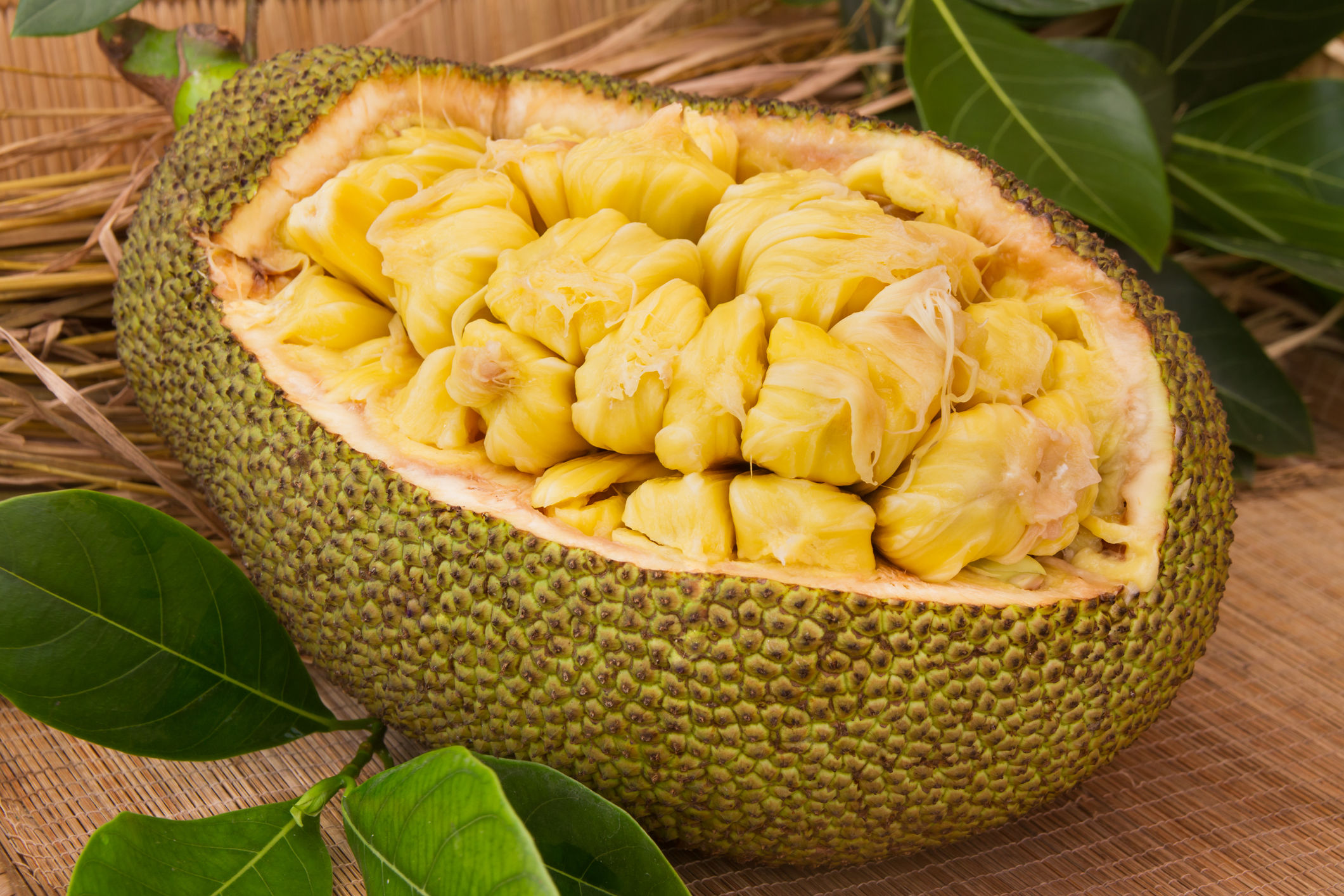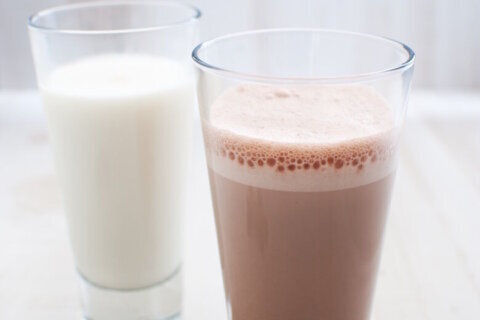
You’ve probably been seeing this ginormous, oblong melon-looking fruit at the grocery store. If you’re a bit intimidated by its huge size, you’re not alone. But the popularity of jackfruit has been soaring, so you’ll probably be seeing it a lot more. Here’s a look at what jackfruit is, where to find it and the best ways to prep and cook it.
What Is Jackfruit?
A member of the figtree, mulberry tree and breadfruit family, jackfruit is the national fruit of Bangladesh and has been around for thousands of years. Archaeologists estimate that jackfruit has been growing in India for 3,000 to 6,000 years. It’s thought that jackfruit trees were planted in Hawaii before 1888. The jackfruit is one of the largest fruits to grow on trees.
A jackfruit looks like an oblong honeydew or large mango with a sweet smell and can weigh up to 50 pounds. It has a green, thick rind with bumps on its surface and a fleshy interior. The seeds are also edible.
According to Abbie Gellman, registered dietitian, chef and owner of Culinary Nutrition Cuisine, “Jackfruit has a texture that is described as similar to pulled pork and is a great alternative for those who are vegan or vegetarian. It takes on other flavors well, lending itself easily to both sweet and savory preparations.”
The fruit can be used ripe or unripe. “To use it in savory dishes, you are actually using immature (or young) jackfruit,” explains dietitian and author Sharon Palmer, aka the Plant-Powered Dietitian, who is based in Los Angeles. “If it were mature, it would be sweet and would be used as a fruit.” Palmer explains why it’s so popular in vegetarian dishes. “Jack fruit has a stringy texture, and it is red-colored. When it is cooked, it actually has the appearance and texture of meat — particularly pulled meat.”
[SEE: Plant-Based Diet Ideas.]
Nutrition Information
One cup of sliced jackfruit provides 155 calories, 39.6 grams of carbs and 2.4 grams of protein. It’s a good source of fiber, vitamins A and C, riboflavin, magnesium, potassium, copper and manganese. It certainly provides numerous nutrients, but not a huge amount of protein. If eaten in a vegetarian diet as a “protein” food, it should still be supplemented with other plant-based proteins like beans, lentils or soy.
Purchasing and Storing
You can find fresh or canned jackfruit at your local grocery or specialty store. Since it takes effort to prep, you can purchase it canned or already sliced. According to Palmer, “It’s really easy just buying it by the can, which is becoming more available in markets in the U.S. Just drain it and pull it apart into strings with your fingers to add to your recipes.”
Canned or whole jackfruit should be stored at room temperature. Sliced jackfruit or leftover canned jackfruit should be stored in the refrigerator for up to four days.
[READ: What Is Butterfly Pea Flower?]
Prepping and Cooking
According to Gellman, prepping a jackfruit is “a bear and probably difficult for most to do at home.” If you choose to prep a fresh one, Gellman recommends to first cover your board with plastic wrap and spray your knife blade with oil spray constantly as the knife will stick. Next, cut into the fruit and make 2-inch slices if possible. Third, cut the slices in half, run blade along the core to split away the pods or bulbs. The bulbs — the fleshy part — can be eaten as is or cut up and cooked. Inside the pods are the seeds. Break the pods off, split lengthwise, and remove seeds and seed skin. Lastly, pull out the flesh.
Like Palmer, Gellman also recommends “to buy it already prepped and ready to go. There are a variety of packaged and canned versions.”
Both Gellman and Palmer provided their favorite ways to prepare jackfruit:
— Barbecue style: Toss jackfruit with your favorite barbecue sauce and braise it on the stovetop over low heat for an hour or in the oven at 350 degrees Fahrenheit for an hour.
— Pulled meat sandwich: Cook jackfruit with a homemade or pre-made barbecue sauce and serve it over buns.
— Mexican style: Mix it with beans, rice and chili powder, and eat it with some corn or flour tortillas.
— Smoothies: Throw it into a smoothie with fruit of your choice.
— Chili: Mix it with beans, tomatoes and seasoning to provide a sort of meaty texture.
— Tacos: Cook with a spicy seasoning blend for taco filing and layer with beans, grains and veggies like cabbage, avocados or tomatoes in tortillas.
[See: Quick and Healthy Dinner Ideas From Nutritionists.]
Palmer was kind enough to provide her recipe for jackfruit tacos below.
Jackfruit Black Bean Quinoa Tacos by Sharon Palmer
Yield: 6 tacos
Ingredients for the avocado crema:
— 1/4 cup cashews, soaked in water.
— 1 small lime, juiced.
— 1 clove garlic.
— 1/4 teaspoon smoked paprika.
— 1 small avocado.
— 3–4 tablespoons soy milk, unsweetened.
— Salt (as desired, optional).
Ingredients for the jackfruit carnitas:
— 1 teaspoon olive oil.
— 1 small onion, diced.
— 1 small jalapeno, finely diced.
— 2 cloves garlic, minced.
— 1 and 1/2 teaspoons chili powder.
— 1/2 teaspoon cumin.
— 1 teaspoon oregano.
— 1 14-ounce can jackfruit, unsweetened and drained.
— 1/4–1 teaspoon hot sauce (depending on your taste preference).
— 1 tablespoon tomato paste.
— 2 small limes, juiced.
— 1 tablespoon soy sauce, gluten-free, reduced sodium.
— Salt (as desired, optional).
Ingredients for the quinoa and black beans:
— 1 teaspoon olive oil.
— 1 15.5-ounce can Cuban-style black beans, drained.
— 1 cup cooked rainbow quinoa. (Rainbow is a tri-color blend of purple, black and white quinoa available at most grocery stores. White quinoa works as well.)
— Salt and pepper (as desired, optional).
For the toppings/base:
— 6 small corn tortillas.
— 1 and 1/2 cups finely shredded green or red cabbage.
— 1/3 cup fresh cilantro, chopped.
Instructions:
1. To make the avocado crema: First, soak the cashews for 20 minutes in water. Prepare remaining steps in this recipe while the cashews are soaking. Drain off water and add cashews, along with lime juice, garlic, paprika and avocado to a blender container. Add soy milk and process until smooth. May add additional soy milk if needed to make a smooth, creamy texture. If desired, season with a pinch of salt (optional). Transfer to bowl.
2. To make the jackfruit carnitas: While cashews are soaking, heat olive oil in a skillet and saute onion, jalapeno and garlic for 5 minutes. Add chili powder, cumin and oregano. Stir well. Add the drained jackfruit, breaking it apart into strands with a fork while it’s cooking (about 2 minutes). Add hot sauce (adjust for your preference of spiciness), tomato paste, lime juice and soy sauce. Continue to cook, breaking apart jackfruit with a fork, for an additional 4 minutes, until vegetables are soft, seasonings are well blended and jackfruit is separated into strands. Remove from heat.
3. To make the black beans and quinoa: While you’re cooking jackfruit carnitas, heat a small skillet and add olive oil. Add drained beans and cooked quinoa. Stir and heat for about 5 minutes, until heated through. May add a pinch of salt and pepper, if desired (optional). Remove from heat.
4. Prepare tortillas: Roast corn tortillas in a toaster oven or the top rack of the oven for about 3 minutes for open-face or folded crispy tacos, or heat them in a pan for 2 minutes for soft tacos.
5. To prepare tacos: Line tacos with a layer of cabbage, black beans and quinoa and jackfruit carnitas. Top with a dollop of avocado crema and garnish with cilantro.
Nutrition information (per taco): 365 calories; 10 g fat; 1 g saturated fat; 13 g protein; 62 g carbs; 13 g fiber; 3 g sugar; 0 mg cholesterol; 137 mg sodium.
More from U.S. News
Sweet Potato Nutrition Facts: 7 Ways This Root Veggie Is Good for You
Home Remedies for Muscle Cramps
What Is Jackfruit and How Do I Use It? originally appeared on usnews.com







